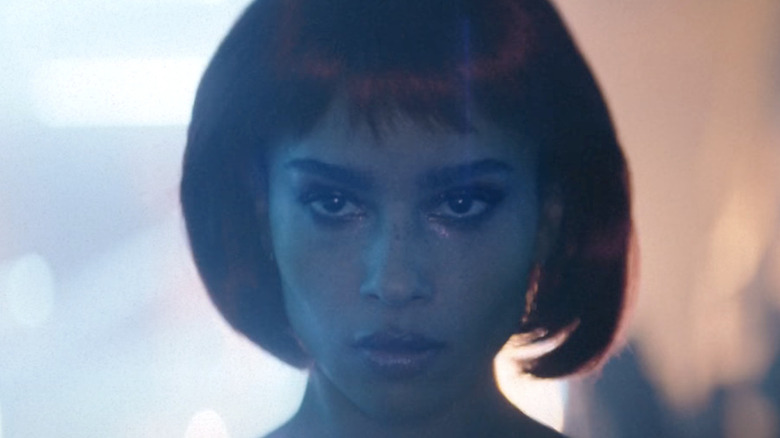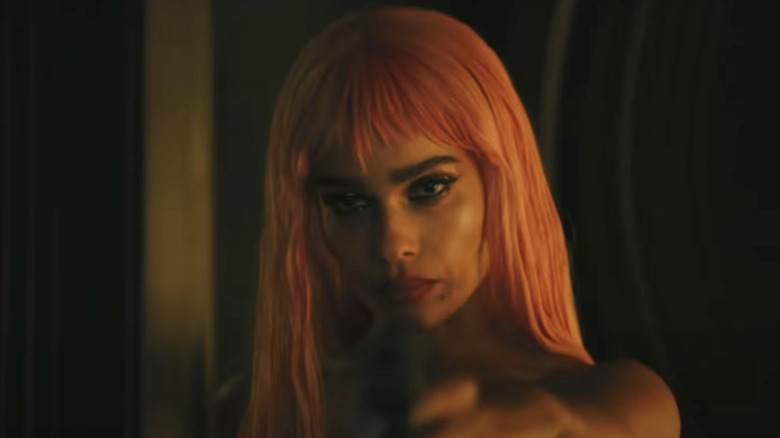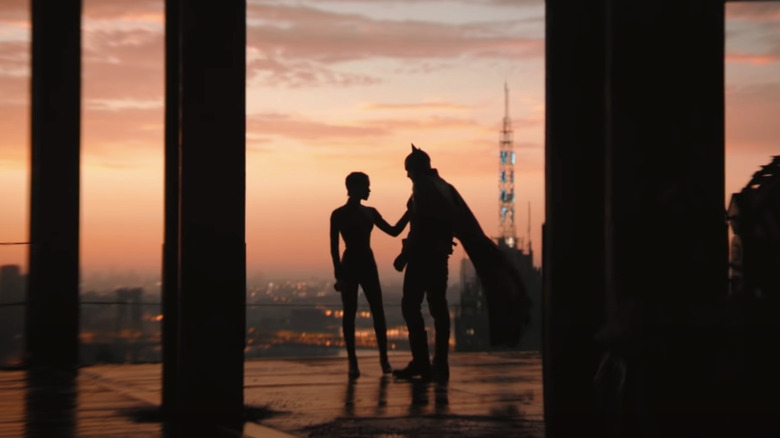Catwoman's Drastic Change In The Batman Explained
Contains spoilers for "The Batman."
Just like with the superhero Batman, we've seen quite a few versions of Catwoman, also known as Selina Kyle, over the years. From Julie Newmar and Eartha Kitt in the "Batman" TV series starring Adam West and Burt Ward to Michelle Pfeiffer and Anne Hathaway in more modern film adaptations, there have been many changes to the character over time. So when it was announced that Zoë Kravitz would be taking on the iconic character for the new "The Batman" movie, directed by Matt Reeves and starring Robert Pattinson, fans should've known to expect something new.
In "The Batman," fans get to see a younger Bruce Wayne (Pattinson) in his early years as the vigilante, and that's the same case with Selina. In the new movie, Selina isn't quite Catwoman yet, though she's well on her way. While she has all of the skills and the drive to become the well-known antihero, she's still just a young woman with some personal issues to take care of. But what else does the 2022 film change about Selina? While there are a few stark changes to the character to note with Kravitz's performance, there's one glaring difference that drives the whole movie forward.
The new film alters Selina Kyle's upbringing and parentage — sort of
In the original DC "Catwoman" comics, Selina's parents are Maria and Brian Kyle, who both tragically die when she is quite young, leading to her life on the street. But the version of Selina we see in "The Batman" doesn't have quite the same experience. Yes, her mother is Maria, but her father is someone very different. It's noted by many that the comics include speculation that Selina's real parents aren't the Kyles, but are really Carmine Falcone and his wife, Louisa (via DC Database). While the comics never explicitly confirm or deny this, "The Batman" decides to concretely change the story and have Falcone be Selina's father. In the movie, Maria works at the Iceberg Lounge and has a relationship of sorts with the mob boss, which results in Selina's birth. There is zero mention of her comic book father Brian, and it seems unlikely that there ever would be in possible future films.
Selina is completely sure that Falcone is her father, but after being abandoned by him after her mother's death (which she later finds out is his doing), she has no real attachment to the man, though she holds strong feelings of resentment and anger. So when Bruce uncovers the true depth of Falcone's crimes, Selina is ever so eager to find Falcone and take him down, stopping him from doing anything else while also getting a chance to confront him about her mother. Add to that the reveal that he's involved in her roommate's death, and you've got just about the worst father-daughter relationship out there.
But aside from the connection with Falcone, "The Batman" also makes one other small yet important change to Selina.
The Batman moves in the right direction to accurately present Catwoman
While this is a very small detail in the new movie, longtime fans of Catwoman in the DC Comics might notice something about the way Selina interacts with her roommate and coworker from the Iceberg Lounge. This detail is actually a change from past screen depictions of Selina, but it makes the character more similar to the comic book version. Luckily for those who missed it, Matt Galea of Pedestrian did not, picking up on hints of an intimate relationship between the two women, especially in how Selina calls her "baby." For those who don't already know, Selina is frequently depicted as bisexual in the comics, which is made canon in "Catwoman" #39 (via DC Comics). So while "The Batman" definitely doesn't confirm Selina's sexuality, there are hints that this aspect of the character may be explored in further films.
Galea was able to ask both Kravitz and Reeves about this specific detail directly, and whether or not it was a purposeful choice in order to highlight her bisexuality in the comics. Kravitz confirmed to Galea for Pedestrian that although it wasn't written in the script, "That's definitely the way I interpreted that, that they had some kind of romantic relationship." Reeves wasn't as definitive with his comments, but he did say that "I don't think we meant to go directly in that way, but you can interpret it that way for sure ... there was meant to be quite an intimate relationship between them." Based on this, it's certainly worth having hope that — if Reeves, Kravitz, and others return for future installments after "The Batman" — Selina's sexuality will finally be accurately presented on screen.


